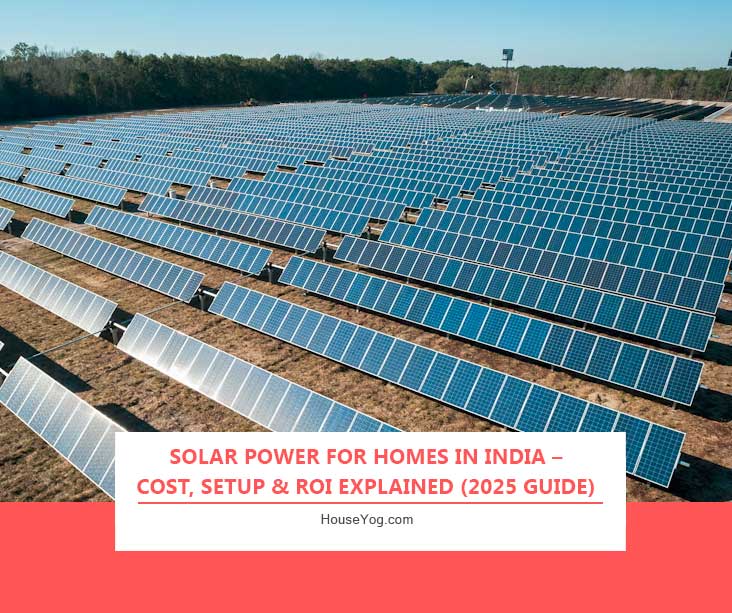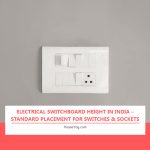If you’ve been thinking about cutting your electricity bills or living more sustainably, installing a solar power system at home might be the smartest move you can make in 2025.
With rising electricity tariffs and new government solar subsidies, switching to solar energy is not just eco-friendly — it’s a high-return investment for Indian homeowners. It helps you save monthly energy costs, reduce grid dependency, and increase your property’s long-term value.
But the most common question is:
“How much does solar power for homes cost in India, and is it really worth the investment?”
In this detailed guide, we’ll break down everything you need to know — including solar power setup cost in India, types of solar systems, subsidies, maintenance, and how to calculate the solar ROI for your home in 2025.
What is a Solar Power System for Homes?
A solar power system for homes is a setup that converts sunlight into usable electricity using solar panels, an inverter, and a battery backup or grid connection. It lets you generate your own clean energy, reduce your dependence on grid power, and save on monthly electricity bills.
In simple terms, solar power systems allow your home to run appliances and lights directly from the sun’s energy — either independently (off-grid) or alongside the main utility supply (on-grid).
There are mainly three types of solar systems used in Indian homes:
| Type | Description | Ideal For |
| On-Grid (Grid-Tied) | Connected to the utility grid, excess power is sent back for credit. | Homes with a stable electricity supply and net-metering support. |
| Off-Grid | Works independently using batteries to store power. | Rural areas or places with frequent power cuts. |
| Hybrid | Combines both grid connection and battery backup. | Urban homes seek reliability and savings. |
Choosing the right system depends on your electricity usage, location, and budget, which we’ll explain in the next section on solar setup costs in India.
Solar Power Home India Cost (2025 Estimate)
The solar power home India cost in 2025 varies mainly by the system’s capacity (in kilowatts or kW), the type of installation (on-grid, off-grid, or hybrid), and the quality of components used.
On average, a 1kW solar system — suitable for small homes with basic appliances — costs around ₹70,000 to ₹1,10,000 (after subsidy). A 3kW system, which can power a 2BHK–3BHK home, typically costs between ₹2.1 lakh and ₹3.3 lakh, while larger 5kW setups can range from ₹3.5 lakh to ₹5 lakh, depending on brand and battery backup.
Here’s a quick breakdown of solar power installation costs in India (2025):
| Capacity | Power for | System Type | Approx. Cost (₹) | Subsidy (₹) | Final Cost (₹) |
| 1 kW | 1BHK home | On-Grid | ₹65,000–₹80,000 | ₹18,000 | ₹47,000–₹60,000 |
| 2 kW | 2BHK home | On-Grid | ₹1.2–₹1.4 lakh | ₹36,000 | ₹84,000–₹1.1 lakh |
| 3 kW | 3BHK home | On-Grid | ₹1.8–₹2.2 lakh | ₹54,000 | ₹1.3–₹1.6 lakh |
| 5 kW | Large home/villa | On-Grid | ₹3–₹3.8 lakh | ₹78,000 | ₹2.2–₹3 lakh |
Note: Prices include solar panels, inverter, structure, and installation. Battery backup or hybrid systems cost 20–30% more.
Pro Tip:
If you live in a high-power consumption household or have frequent power cuts, go for a hybrid solar setup — it gives you grid backup and battery storage.
The final solar power home cost also depends on installation height (terrace vs. ground-mounted), inverter brand, panel efficiency (Mono PERC, Polycrystalline, or Bifacial), and local labour rates.
Key Factors That Impact Solar Power Home Installation Cost
Just like any other major home investment, the solar power installation cost in India depends on several factors — from the system type and capacity to roof design, location, and even the quality of components you choose. Understanding these factors can help you plan your budget better and choose the right setup for your home.
- System Capacity (kW): The more power you need, the larger (and more expensive) your system will be.
- Panel Type:
- Polycrystalline panels (cheaper, slightly less efficient)
- Monocrystalline panels (costlier, but highly efficient)
- Mounting Structure: Tilt angle, roof type (flat or sloped), and material affect installation charges.
- Inverter Type: On-grid inverters are cheaper; hybrid and off-grid inverters cost more.
- Battery Backup: Optional, but adds ₹50,000–₹1 lakh depending on capacity.
- Location & Labour: Installation costs vary by region (₹5,000–₹15,000 range).
- Government Subsidy: Central and state-level schemes can reduce costs by up to 40%.
Government Subsidies & Schemes (2025 Update)
The Indian government offers subsidies under the Rooftop Solar Programme (Phase II) for residential customers.
| Capacity | Subsidy (₹) |
| Up to 2 kW | ₹18,000 per kW |
| 2–3 kW | ₹18,000 for first 2 kW + ₹9,000 per additional kW |
| Above 3 kW | ₹45,000 (fixed) |
You can apply through the National Portal for Rooftop Solar (https://solarrooftop.gov.in).
Most DISCOMs also assist with installation and net-metering support.
Tip: Always choose MNRE-approved vendors to ensure you qualify for the subsidy and warranty support.
Maintenance & Lifespan
A properly installed solar system can last 20–25 years.
The only regular task is to clean the panels every 10–15 days to remove dust and debris.
| Component | Lifespan | Maintenance |
| Solar Panels | 25 years | Cleaning only |
| Inverter | 8–10 years | Occasional replacement |
| Battery (if any) | 5–7 years | Regular check-ups |
Annual maintenance cost: ₹1,500–₹3,000 approx.
ROI from Solar Panels in India (2025 Analysis)
Let’s see how solar power pays for itself:
Example:
A 3 kW system costs ₹1.5 lakh (after subsidy).
It generates about 12–14 units/day = 4,200–5,000 units/year.
If electricity costs ₹7 per unit:
→ Annual savings ≈ ₹30,000–₹35,000
→ ROI Period = 4–5 years
→ Lifespan = 20+ years
→ Total Lifetime Savings: ₹5–6 lakh (approx.)
Verdict: After 4–5 years, your electricity is virtually free for the next 15+ years — making it one of the best long-term home investments in India.
How to Set Up a Solar Power System at Home (Step-by-Step Guide)
Setting up a solar power system for your home in India is a simple process when done with the right vendor. Here’s a step-by-step breakdown of how it works:
1. Assess Your Power Usage
Review your past 6–12 months’ electricity bills to understand your average monthly units (kWh). This helps decide the right solar capacity (kW) for your needs.
2. Choose the Right System Type
On-Grid System: Best for lowering monthly electricity bills.
Hybrid or Off-Grid System: Ideal if you want power backup during outages.
3. Select an MNRE-Approved Solar Vendor
Work with a MNRE-approved installer who can help with site design, system selection, net-metering, and government subsidy documentation.
4. Site Inspection & Cost Estimate
A technician will visit your home to assess the roof direction, shade, and load requirements, followed by a detailed quotation.
5. Installation & Testing
The vendor installs the solar panels, inverter, and net meter, ensuring all wiring and safety standards are met.
6. Commissioning & Subsidy Claim
After installation, the system is tested and approved by your local DISCOM. The vendor then submits your subsidy application under the Rooftop Solar Scheme.
Installation Time: Usually 5–10 days for most residential setups, depending on system size and weather conditions.
Solar Power vs Traditional Electricity
Before deciding, it’s important to compare solar power for homes with regular grid electricity in terms of cost, maintenance, and long-term benefits:
| Feature | Solar Power | Regular Grid Power |
| Source | Renewable (sunlight) | Coal-based generation |
| Monthly Bills | Minimal | Ongoing |
| Lifespan | 20–25 years | N/A |
| Maintenance | Low | Continuous payments |
| ROI | 4–6 years | None |
| Eco Impact | Clean, green energy | High carbon footprint |
Takeaway: Solar power is a one-time investment that keeps paying you back year after year.
Frequently Asked Questions about Solar Power for Homes in India
The installation cost for a residential solar power system in India ranges between ₹65,000 and ₹3.5 lakh, depending on system capacity (1–5 kW) and type — on-grid, hybrid, or off-grid.
Most homeowners can expect a return on investment (ROI) of 4–6 years, depending on electricity usage, system size, and local tariff rates.
Yes, solar panels still generate electricity during cloudy or rainy days, though efficiency may drop by 10–25%.
Absolutely. A 3–5 kW solar system is sufficient to power essential household appliances like air conditioners, refrigerators, and lighting.
Battery backup is optional for on-grid systems. It’s recommended only in areas with frequent power outages or for hybrid/off-grid setups.
Over to You
Installing solar power for your home in India is not just about cutting power bills, but it’s also about energy independence, sustainability, and long-term savings.
In 2025, a typical on-grid solar system costs between ₹65,000 and ₹3.5 lakh, depending on size and type. With subsidies and 25-year warranties, you recover your investment in just a few years — and enjoy free electricity for decades.
At Houseyog, we help homeowners plan smarter — from architectural design and MEP planning to energy-efficient construction. You can also use our Construction Cost Calculator or connect with our experts to plan your dream home with smart, sustainable solutions.Share this guide with friends and family who are planning to build or renovate their homes, and help them make informed, sustainable choices!






